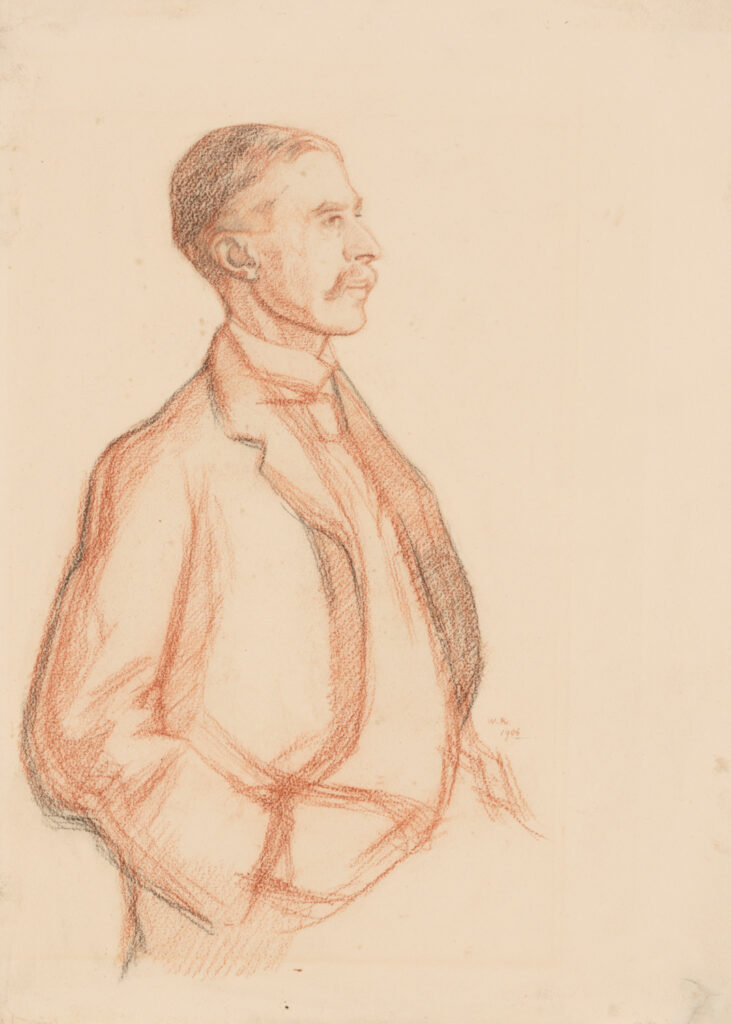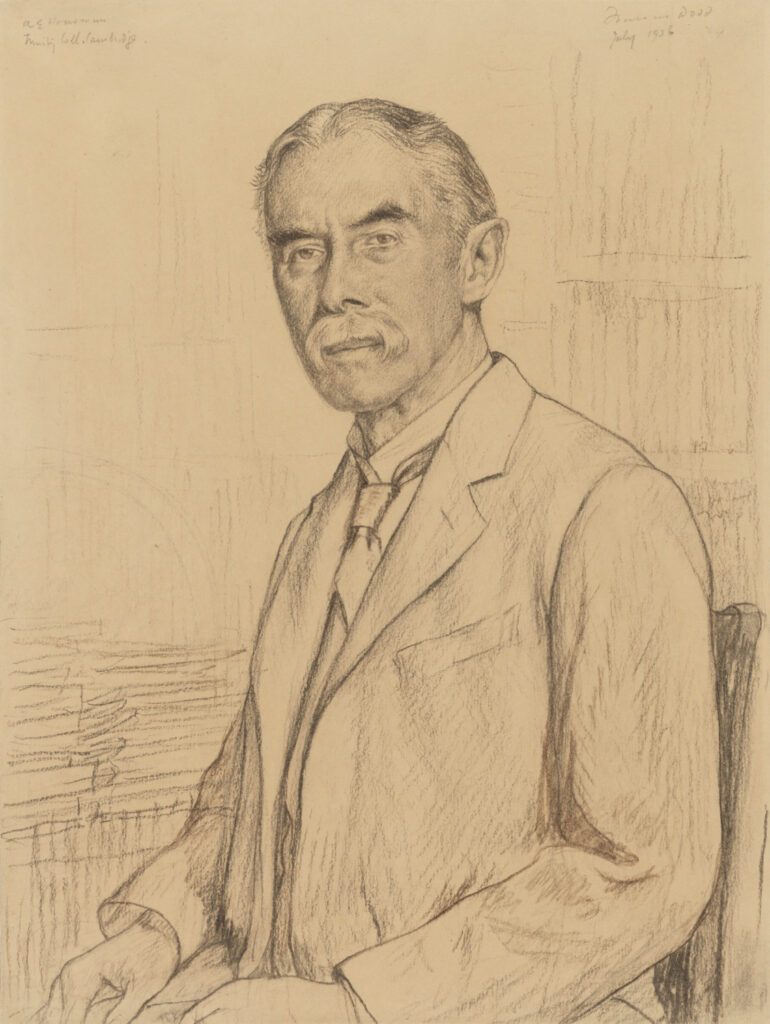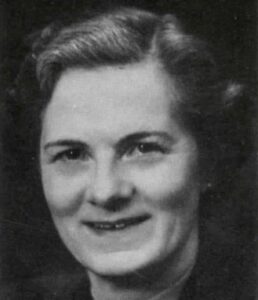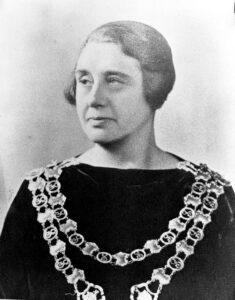

June suns, you cannot store them
A. E. Housman, More Poems XXII, published 1836
To warm the winter’s cold,
The lad that hopes for heaven
Shall fill his mouth with mould
Alfred Edward Housman was a scholar of classics, a poet, and an atheist, best known for his collection A Shropshire Lad (1896). This was highly influential on future authors, such as the humanist George Orwell, who said that he could probably remember the whole of the collection, and that ‘these were the poems which I and my contemporaries used to recite to ourselves, over and over, in a kind of ecstasy.’ Housman published two volumes of poetry during his lifetime, supplemented by additional publications organised after his death by his brother, Laurence Housman, a Vice President of the Ethical Union (now Humanists UK).
Like many humanists of the 19th century, Housman found inspiration in the classical world, recalling in an interview in later life: ‘a copy of Lempriere’s “Classical Dictionary” fell into my hands when I was eight and attached my affections to paganism.’
It is and it must in the long run be better for a man to see things as they are than to be ignorant of them; just as there is less fear of stumbling or of striking against corners in the daylight than in the dark.
A. E. Housman, Introductory lecture as professor of Latin at University College London, 3 October 1892

A.E. Housman was born in Worcestershire, the first of seven children born to Edward Housman and Sarah Jane Housman (née Williams). Alfred’s mother was the daughter of a reverend and his father was a politically and religiously conservative solicitor. While on a scholarship at Bromsgrove School, he was deeply affected by the death of his mother on his 12th birthday. Later in life, he reflected that he ‘became a deist at thirteen and an atheist at twenty-one’.
At 21, Housman was studying classics at St John’s College, Oxford, and moving in with Moses Jackson, a science scholar who he’d fallen in love with at university. Housman’s poem ‘De Amacitia’ (‘Of Friendship’) conveyed his unrequited feelings for Moses Jackson, and was published by his brother, Laurence, after his death.
In 1937, Laurence also deposited an essay with the British Library, under stipulations that it remained sealed for 25 years. It detailed Alfred’s feelings for Moses and his hope that, after the 25 years had passed, ‘society may, at long last, have acquired significant common sense to treat the problem less unintelligently, less cruelly, more scientifically’. Like his brother, who co-founded the British Society for the Study of Sex Psychology, Alfred collected books on sexology—a growing field of study that rejected religious condemnation of homosexuality in favour of the rational study of sexuality.
Leaving university in 1881, Alfred worked on trade marks for ten years in the civil service, spending evenings in the British Museum Library where he developed dozens of academic papers on classical texts. In 1892, he accepted the professorship of Latin at University College London. Soon after his appointment, Housman gave a lecture on the pursuit of knowledge and happiness which typifies his most humanist views. It was published in 1937, the year after his death, in a very large print run and sold well in both the UK and US, demonstrating his status as one of the preeminent public intellectuals of the early 20th century.

On the joy of knowledge, Housman wrote: ‘The desire of knowledge does not need, nor could it possibly possess, any higher or more authentic sanction than the happiness which attends its gratification’. And on the desirability of facing the truth about human origins rather than religious myths:
It may be urged that the light shed on the origin and destiny of man by the pursuit of truth in some directions is not altogether a cheerful light. It may be urged that man stands to-day in the position of one who has been reared from his cradle as the child of a noble race and the heir to great possessions, and who finds at his coming of age that he has been deceived alike as to his origin and his expectations; that he neither springs of the high lineage he fancied, nor will inherit the vast estate he looked for, but must put off his towering pride, and contract his boundless hopes, and begin the world anew from a lower level: and this, it may be urged, comes of pursuing knowledge. But even conceding this… The house of delusions is cheap to build, but draughty to live in, and ready at any instant to fall; and it is surely truer prudence to move our furniture betimes into the open air than to stay indoors until our tenement tumbles about our ears. It is and it must in the long run be better for a man to see things as they are than to be ignorant of them; just as there is less fear of stumbling or of striking against corners in the daylight than in the dark.
On the pursuit of happiness, Housman argued:
The complexity of the universe is infinite, and the days of a man’s life are threescore years and ten. One lifetime, nine lifetimes are not long enough for the task of blocking every cranny through which calamity may enter. And say that we could thus triumphantly succeed in the attempt at self-preservation; say that we could thus impregnably secure the necessaries of existence; even then the true business of life is not so much as begun. Existence is not itself a good thing, that we should spend a lifetime securing its necessaries: a life spent, however victoriously, in securing the necessaries of life is no more than an elaborate furnishing and decoration of apartments for the reception of a guest who is never to come. Our business here is not to live, but to live happily.

Alongside his teaching, Housman continued his poetry writing and was active in the university’s literary society. Keenly aware of contemporary English poets, he responded to the trial of Oscar Wilde for ‘gross indecency’ in 1895, writing ‘Oh who is that young sinner?’, a poem that satirised the unfairness of the treatment of gay men, based on the understanding (perhaps founded in his studies of sexology) that homosexuality is an inherent aspect of identity, rather than something freely chosen. Starting and ending the poem with reference to ‘sin’ and ‘God’, Housman highlights the logical inconsistency of religious definitions of human nature that exclude homosexuality (using the analogy of hair) – ”Tis a shame to human nature, such a head of hair as his’. A friend of Oscar Wilde’s read Housman’s poetry publication, A Shropshire Lad, to Wilde in prison, and when he was released, Housman sent him a copy.
In 1910, Housman took up a position as the chair of Latin at Trinity College, Cambridge. He remained here for the rest of his life, although frequently took holidays to France and Italy where attitudes to homosexuality were more tolerant and he could access publications that were either legally or effectively censored in the UK.
Only a week before his death he gave the first two lectures advertised for the Easter term of 1936, but was too weak to continue. He died from myocarditis in the Evelyn Nursing Home on 30 April 1936, and his ashes were buried at St Laurence’s Church in Shropshire.
His little poems are no carved cherry-stones. They hold in simple, imperishable perfection of form the simple, imperishable feelings of all humanity.
‘A.E. Housman, The poet, dead‘, Central Somerset gazette, 8 May 1936
Writing for Housman’s memorial plaque in Trinity College Chapel, A.S.F. Gow said of Housman that:
he corrected the transmitted text of the Latin poets with so keen an intelligence and so ample a stock of learning, and chastised the sloth of editors so sharply and wittily, that he takes his place as the virtual second founder of textual studies. He was also a poet whose slim volumes of verse assured him of a secure place on the British Helicon.
In 1985 a statue of Housman was unveiled at Bromsgrove in his honour. Then, in 1996, Housman was given a memorial panel in the window above Geoffrey Chaucer’s monument in the Poets’ Corner of Westminster Abbey, alongside the likes of Oscar Wilde and Christopher Marlowe.
Norman Page, A. E. Housman: A Critical Biography (1996)
A. E. Housman is one of the historical figures featured in Picturing Nonconformity: LGBT Humanist Heritage, created for the 45th anniversary of LGBT Humanists in 2024. Explore the exhibition.
Main image: A.E. Housman, photographed by E.O. Hoppé, c.1911 © National Portrait Gallery, London


Rationalism is… primarily a mental attitude, not a creed or a definite body of negative conclusions. No uniformity of opinions […]

With these basic [humanist] beliefs there go commonly two corollaries. First, that virtue is a matter of promoting human well-being, […]

No law can be effective which has not behind it the sanction of the people. Dorothy Thurtle, quoted by David […]

I see this kind of love – the empathy that should be common to all living creatures – rather than […]